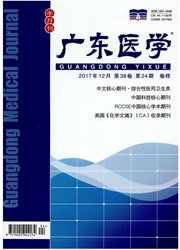

 中文摘要:
中文摘要:
目的分析重症监护室(ICU)院内感染的危险因素及院内感染细菌耐药现状。方法回顾性分析浙江省长兴县中医院ICU487例患者资料,对院内感染的危险因素、感染部位及种类进行分析;同时对病原菌进行药敏分析,判断细菌对常用抗生素的耐药情况。结果ICU院内感染率为23.2%,感染组高龄患者、发生低蛋白血症的患者比率明显高于未感染组(P〈0.05),感染组采取中心静脉置管和呼吸机患者的比率明显高于未感染组(P〈0.05),口腔黏膜和呼吸道系统是感染的常见部位。细菌耐药性检测发现,ICU细菌耐药情况十分严重.有的甚至已经完全耐药。结论ICU应加强规范性操作,尤其是对老龄患者、发生低蛋白血症患者及采取中心静脉置管和呼吸机患者应给予高度重视,减少患者病原菌暴露机会。此外,需要注意抗生素的合理使用,避免耐药的发生。
 英文摘要:
英文摘要:
Objective To analyze the risk factors of nosocomial infection in ICU department and the situation of bacte- rial resistance of nosocomial infection. Methods Data of 487 cases in ICU department of Hospital of Traditional Chi- nese Medicine in Changxing County, Zhejiang Province were analyzed retrospectively, then the risk factors of nosoeo- mial infections, infection sites and species were analyzed, at the same time, sensitivity analysis of pathogen was carried out to determine the antibiotic resistance of bacteria. Results The ICU nosocomial infection rate was 23.2%. In the in- fection group, elderly patients and the hypoproteinemia patients were significantly higher than those in the control group (P 〈 0.05), which also had a significantly higher central venous catheter and ventilator patients ratio than that in the control group (P 〈 0.05). The oral mucosa and respiratory system were common infection sites. The bacterial drug resistance test results showed that, drug-resistance of ICU bacterial was very serious, and some had even com- pletely resistance. Conclusion The ICU should strengthen the normative operations, especially for elderly patients, pa- tients with hypoproteinemia, and patients with central venous catheter and ventilator treatment should be given great importance to reduce the opportunity of pathogen exposure. In addition, the rational use of antibiotics need to be paid attention to, in order to avoid the occurrence of drug resistance.
 同期刊论文项目
同期刊论文项目
 同项目期刊论文
同项目期刊论文
 期刊信息
期刊信息
